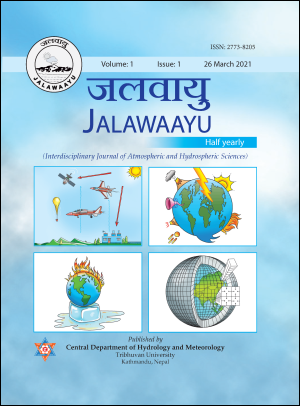Observations and climate models confirm precipitation pattern is changing over Nepal
DOI:
https://doi.org/10.3126/jalawaayu.v1i1.36448Keywords:
Climate model, Gauge-based observation, Precipitation indices, Shared Socioeconomic Pathway (SSP)Abstract
This paper presents a comprehensive picture of precipitation variability across Nepal over the present (1985-2014) and future (2021-2050) based on gauge-based observations from 28 precipitation stations distributed throughout the country and thirteen climate models of the latest Coupled Model Intercomparison Project Phase 6 (CMIP6) under two Shared Socioeconomic Pathways (SSP 245 and SSP 585). Seventeen different precipitation indices are computed using daily precipitation data based on gauge-based observations and climate models. Along with absolute extreme precipitation indices, such as maximum 1-day, maximum consecutive 3-day, 5-day, and 7-day precipitation amounts, this study also computes the contribution of such instances to the annual precipitation. The selected precipitation indices not only allow for the analyses of heavy precipitation-related extremes but also guide the evaluation of agricultural productivity and drought indications, such as consecutive dry and wet days (CDD and CWD). The number of wet days and average precipitation during those wet days, along with the information of the number of days with daily precipitation ≥ 10, 20, 50, and 100 mm, summarize the distribution of total precipitation. This study emphasizes changing precipitation patterns by looking at these indices over the present and future periods. Observations and climate models show a changing nature of precipitation over Nepal. However, different climate models exhibit a different severity of changes. Though the yearly precipitation amount is not altered noticeably, this study finds that the extremes are expected to alter significantly than the averages. It is also to be noted that climate models are unable to capture localized extremes in Nepal Himalayas.
Downloads
Downloads
Published
How to Cite
Issue
Section
License
Copyright © of the articles is held by the authors.

